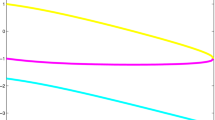Bazley’s special choice operator is a lesser operator to a positive perturbation of a self-adjoint semi-bounded operator that possesses an exactly soluble base eigenvalue problem. It allows the construction of an exactly soluble intermediate problem that gives eigenvalues not less than the base problem and not greater than the perturbed problem so that lower bounds to the eigenvalues of the perturbed operator are produced. This paper considers alternate derivations of Bazley’s special choice which lead to two alternate methods to determine eigenvalue lower bounds. One is simpler, but gives poorer bounds; the other is more difficult, but sometimes yields superior bounds. Lower bounds to the particle in a box model with a linear perturbation and lower bounds to the helium atom are calculated using the two methods introduced and are compared to those given with Bazley’s special choice.
Similar content being viewed by others
References
Kinoshita T. (1959). Phys. Rev. 115: 366
Lüchow A., Kleindienst H. (1994). Int. J. Quantum Chem. 51: 211
King F.W. (1995). J. Chem. Phys. 102: 8053
Hertel P., Lieb E.H., Thirring W. (1975). J. Chem. Phys. 62: 3355
W.M. Greenlee and D.M. Russell, in: Numerical Treatment of Eigenvalue Problems, Vol. 3, International Ser. Numerical Math. 69 (1983) 89.
Marmorino M.G. (2000). J. Math. Chem. 27: 31
Bazley N.W. (1960). Phys. Rev. 120: 144
Fox D.W., Sigillito V.G. (1972). J. Appl. Math. Phys. 23: 392
Reid C.E. (1974). Chem. Phys. Lett. 26: 243
Russell D.M., Greenlee W.M. (1985). Phys. Rev. Lett. 54: 665
Porras I., Feldmann D.M., King F.W. (1999). Int. J. Quantum Chem. 71: 455
Seto R., Stankevich I.V. (1999). Int. J. Quantum Chem. 72: 101
Bazley N., Fox D. (1966). J. Angew. Math. 223: 142
Bazley N.W. (1961). J. Math. Mech. 10: 289
Miller W.H. (1969). J. Chem. Phys. 50: 2758
Rosenberg L., Spruch L., O’Malley T.F. (1960). Phys. Rev. 118: 184
Wilson E.B. Jr. (1965). J. Chem. Phys. 43: S172
Bazley N.W., Fox D.W. (1962). J. Math. Phys. 3: 469
Miller W.H. (1965). J. Chem. Phys. 42: 4305
Uchiyama M. (2003). Trans. Am. Math. Soc. 355: 4111
Author information
Authors and Affiliations
Corresponding author
Rights and permissions
About this article
Cite this article
Marmorino, M.G. Alternatives to Bazley’s special choice for eigenvalue lower bounds. J Math Chem 43, 966–975 (2008). https://doi.org/10.1007/s10910-007-9270-6
Received:
Revised:
Published:
Issue Date:
DOI: https://doi.org/10.1007/s10910-007-9270-6




